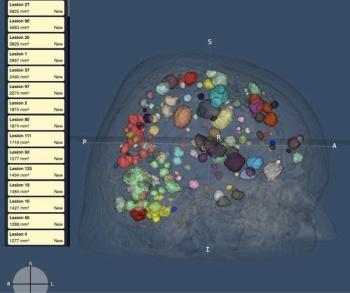
Glaucoma drainage implants and MRI safety
A drainage implant or device, also known as a tube shunt, is implanted in the sclera of patients with glaucoma to maintain an artificial drainage pathway and control intraocular pressure. Intraocular pressure is lowered when aqueous humor flows from inside the eye through the tube into the space between the plate that rests on the scleral surface and surrounding fibrous capsule.(1-3)
A drainage implant or device, also known as a tube shunt, is implanted in the sclera of patients with glaucoma to maintain an artificial drainage pathway and control intraocular pressure. Intraocular pressure is lowered when aqueous humor flows from inside the eye through the tube into the space between the plate that rests on the scleral surface and surrounding fibrous capsule.(1-3)
The implantation of a drainage device is used to treat glaucoma that is refractory to medical and standard surgical therapy.(1-3) These are usually cases in which standard drainage procedures have failed or patients have a poor prognosis. These cases involve failed trabeculectomy, buphthalmos and juvenile glaucoma, neovascular glaucoma and glaucoma secondary to uveitis, traumatic glaucoma, cataract with glaucoma, and high-risk primary glaucoma.(1-3)
For certain glaucoma drainage implants, radiographic findings may suggest detection of an orbital foreign body if the ophthalmic history is unknown, as reported by Ceballos and Parrish.(3) In this case report, a patient was denied an MRI examination for fear of dislodging an apparent "metallic foreign body." In fact, the patient had a Baerveldt glaucoma drainage implant, which was mistakenly identified as an orbital metallic object based on its radiographic characteristics (i.e., due to the presence of barium-impregnated silicone.(3)
At least one glaucoma drainage implant, the ExPRESS miniature glaucoma shunt (Optonol, Neve Ilan, Israel) is made from 316L stainless steel.(4,5) However, many glaucoma drainage implants are made from nonmetallic materials and are safe for patients undergoing MRI procedures.(3) Commonly used devices that do not contain metal include the following:
- Baerveldt glaucoma drainage implant (Pharmacia, Kalamazoo, MI)
- Krupin-Denver eye valve to disc implant (E. Benson Hood Laboratories, Pembroke, MA)
- Ahmed glaucoma valve (New World Medical, Rancho Cucamonga, CA)
- Molteno drainage device (Molteno Ophthalmic, Dunedin, New Zealand)
- Joseph valve (Valve Implants, Hertford, England)
Frank G. Shellock, Ph.D., FACC, FACSM, is an adjunct clinical professor of radiology and medicine at Keck School of Medicine, University of Southern California, and Institute for Magnetic Resonance Safety, Education, and Research.
www.MRIsafety.com
www.IMRSER.org
References
1. Sidoti PA, Baerveldt G. Glaucoma drainage implants. Curr Opin Ophthalmol 1994;5:85-98.
2. Hong CH, Arosemena A, Zurakowski D, Ayyala RS. Glaucoma drainage devices: a systematic literature review and current controversies. Surv Ophthalmol 2005;50:48-60.
3. Ceballos EM, Parrish RK. Plain film imaging of Baerveldt glaucoma drainage implants. AJNR 2002;23;935-937.
4. Traverso CE, De Feo F, Messas-Kaplan A, et al. Long term effect on IOP of a stainless steel glaucoma drainage implant (Ex-PRESS) in combined surgery with phacoemulsification. Br J Ophthalmol 2005;89:425-429.
5. Dahan E, Carmichael TR. Implantation of a miniature glaucoma device under a scleral flap. J Glaucoma 2005;14:98-102.
Newsletter
Stay at the forefront of radiology with the Diagnostic Imaging newsletter, delivering the latest news, clinical insights, and imaging advancements for today’s radiologists.




